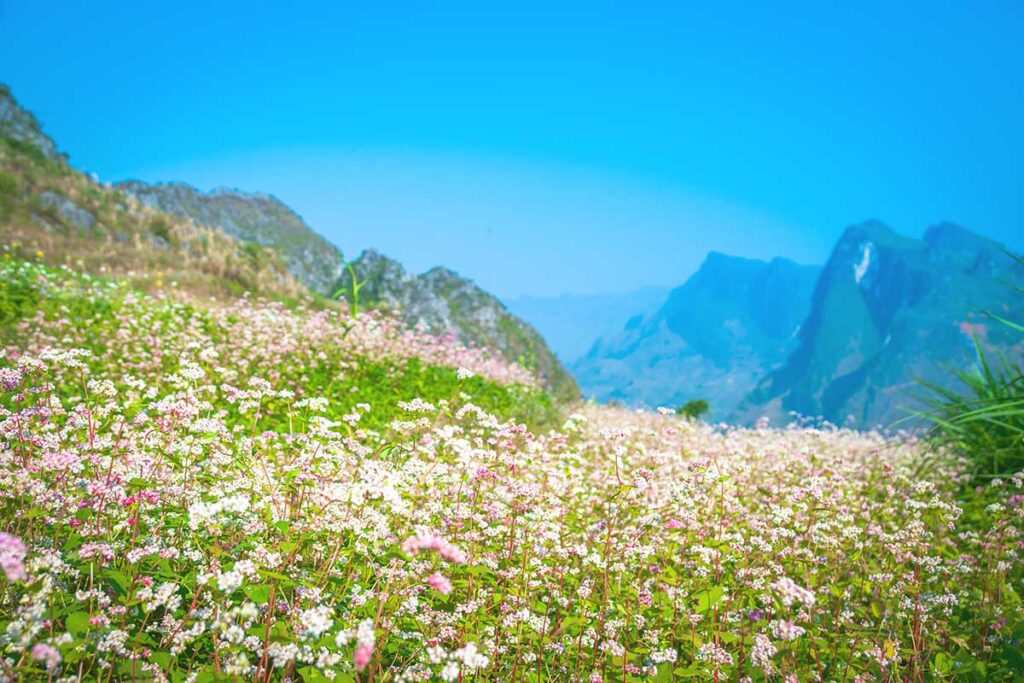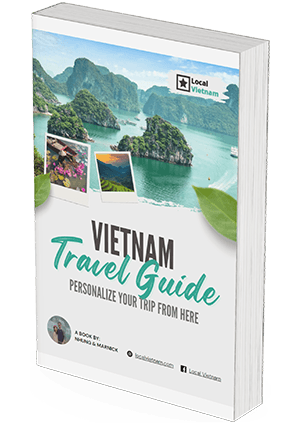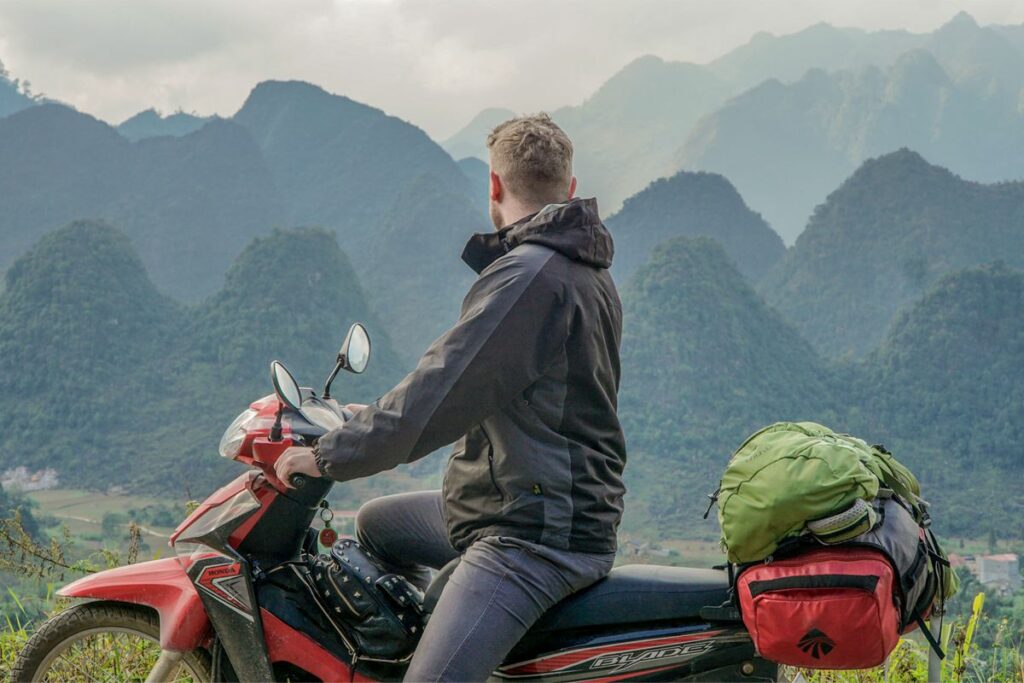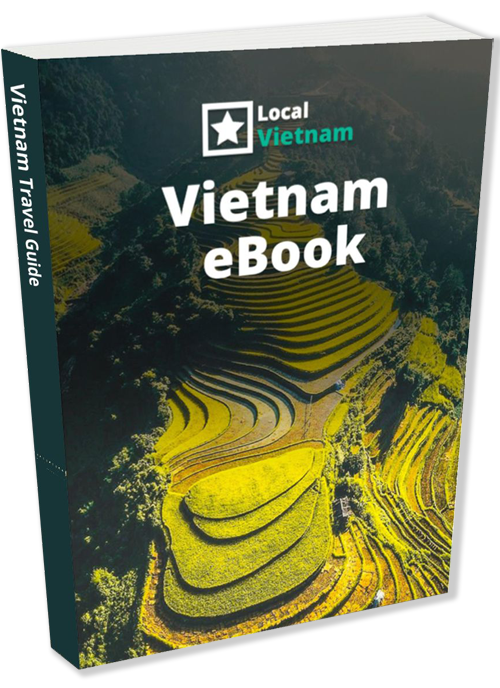Understanding the climate of Ha Giang
Ha Giang is located in northern Vietnam, bordering China, and is famous for its stunning mountain terrain and remote beauty. Its higher altitude and rugged geography create a cooler, more temperate climate compared to Vietnam’s lowland regions. The region experiences four seasons, with November offering cool and dry conditions, perfect for outdoor activities.
The Ha Giang Loop traverses multiple districts, each with its own microclimate. Ha Giang City, located at a lower altitude, tends to be warmer, while areas like Dong Van and Meo Vac, at higher elevations, are noticeably cooler, especially in the mornings and evenings.
While November is relatively stable, conditions can still change quickly in the mountains. One side of a mountain may bask in sunshine while the other is misty or breezy, so it’s best to be prepared for minor fluctuations.
The dry season ensures that skies remain mostly clear, offering unblocked views of Ha Giang’s breathtaking landscapes. Unlike the winter months when fog is common, November offers some of the clearest vistas along the loop.
Weather in Ha Giang in November
November marks the middle of Ha Giang’s dry season, offering stable and pleasant weather. Daytime temperatures in the lower valleys, such as Ha Giang City, range from 22°C to 26°C (72°F to 79°F), while higher altitudes like Dong Van and Meo Vac are cooler, with daytime temperatures between 15°C and 20°C (59°F to 68°F). Nights and early mornings in the mountains can get chilly, with temperatures dropping to as low as 10°C (50°F). Weather conditions can vary from one area to another—one day might be sunny and warm, while another might feel cooler due to mountain breezes or light mist.
Rainfall is minimal in November, as the region is well into its dry season. The chance of rain is low, and when it does occur, it’s typically light and short-lived. Unlike the winter months, clouds and fog are rare, ensuring clear views of the stunning landscapes. The lack of rain also makes road conditions safer and ideal for motorbike travel.
Is November a good time to do the Ha Giang Loop?
Yes, November is an excellent time to do the Ha Giang Loop. The dry, stable weather and clear skies make for enjoyable riding conditions and stunning views of the mountains and valleys. The mild daytime temperatures and crisp mornings create a refreshing atmosphere, and the absence of rain means roads are dry and easy to navigate.
Challenges in November are minimal, but there are a few considerations to keep in mind. Nights and early mornings can be quite cold, especially in high-altitude areas like Dong Van and Meo Vac, so you’ll need to pack warm clothing. Additionally, with the sun setting earlier, it’s important to plan your routes carefully to ensure you reach your destination before dark. Traditional homestays may lack heating, so travelers sensitive to cold should consider booking accommodations with additional amenities or bring extra layers for sleeping.
Highlights of Ha Giang in November
November in Ha Giang is a perfect blend of cultural experiences and stunning natural beauty. The weather is cool and dry, making it ideal for trekking, exploring ethnic villages, and enjoying breathtaking views along the Ha Giang Loop. Below are the highlights to look forward to during your visit this month.
1. Join traditional ethnic festivals
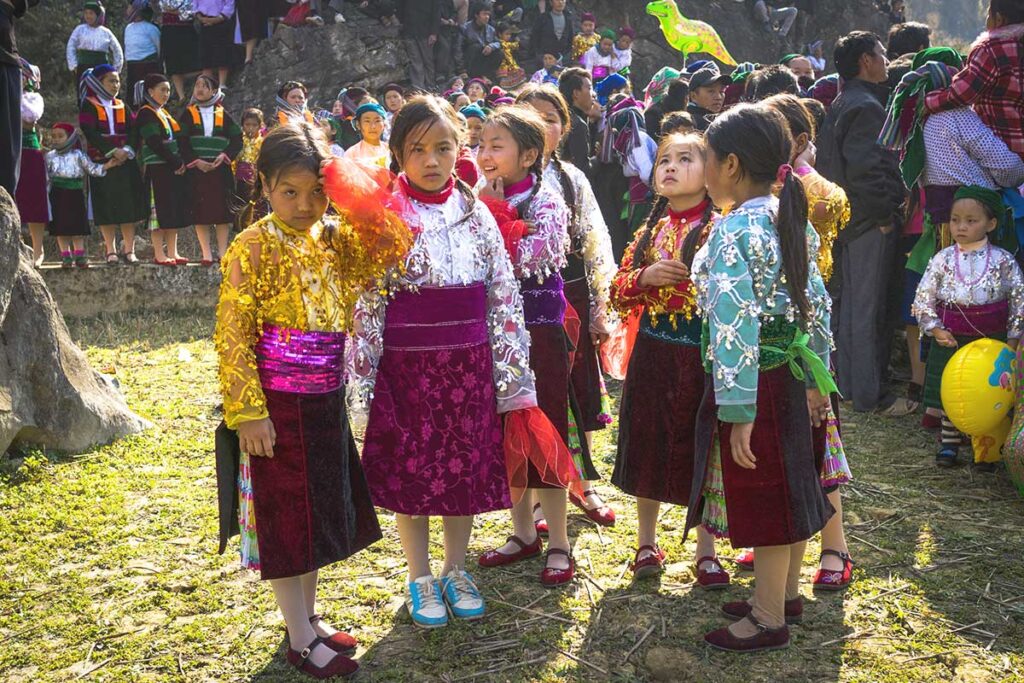
November is an excellent time to witness the unique traditions of Ha Giang’s ethnic minorities through their festivals (they are sometimes held in October, depending on the lunar calendar).
- Du Stem Festival of the Nung People: This lively festival involves traditional games, music, and rituals celebrating community and harvest. It’s a fantastic way to experience the Nung people’s rich cultural heritage.
- Pa Then Fire Dancing Festival: This rare and mesmerizing event showcases Pa Then men dancing barefoot on hot embers, symbolizing spiritual strength and courage. Taking place in remote villages, it’s a once-in-a-lifetime cultural experience.
2. View of buckwheat flowers
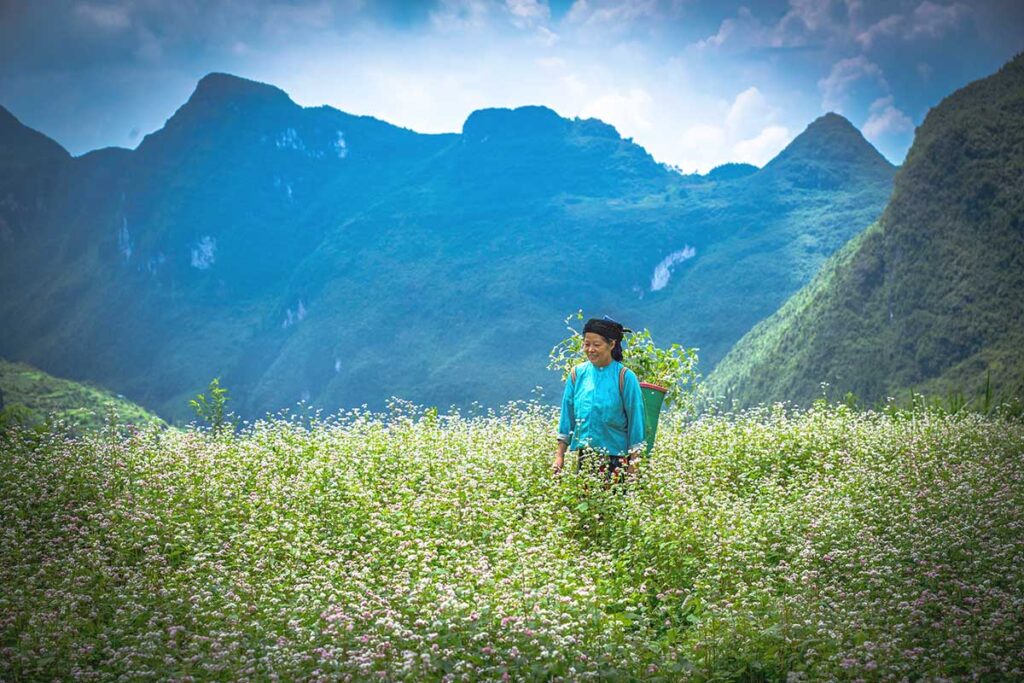
November is one of the best months to see Ha Giang’s famous buckwheat flowers, which blanket the region in pink and white hues. These blooms are especially vibrant in areas like Quan Ba, Lung Cu, and Lung Cam, offering perfect backdrops for photography. Many fields are accessible along the Ha Giang Loop, allowing travelers to stop and admire these stunning flowers.
3. Stay in ethnic homestays
Staying in an ethnic homestay in November offers a chance to experience the local culture while enjoying the region’s mild weather. Homestays in higher-altitude villages like Dong Van and Meo Vac can get a bit chilly at night as they often lack proper heating, but they do provide an authentic glimpse into rural life and are particularly cozy this time of year. While basic, these accommodations are rich in hospitality, offering home-cooked meals and cultural exchanges with local families.
4. Trekking along the Ha Giang Loop
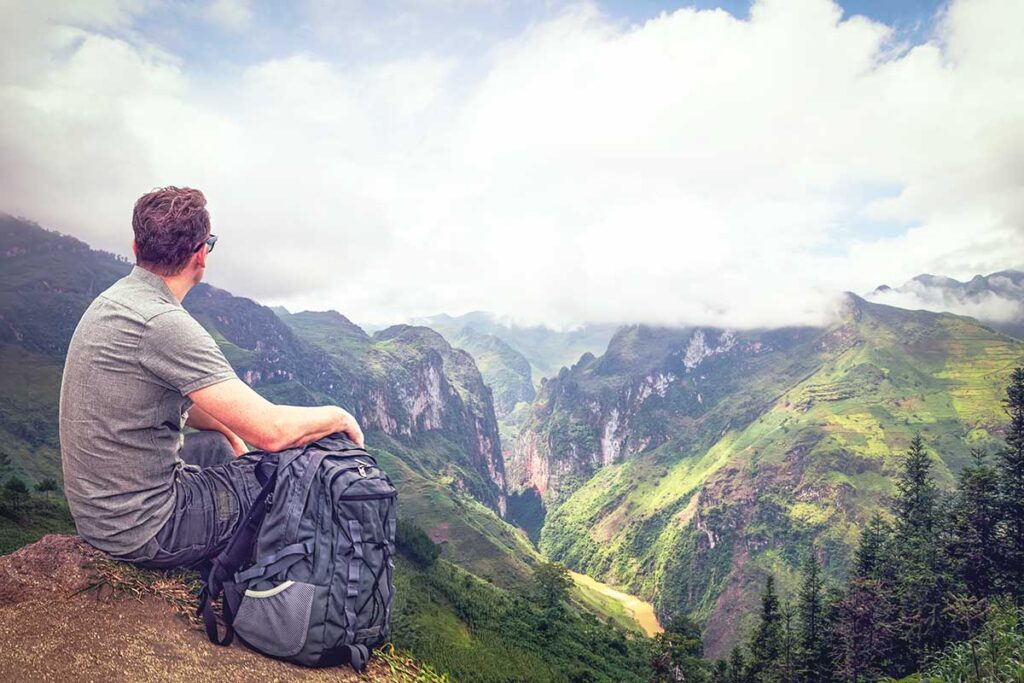
November’s dry weather and mild temperatures make it a great time for trekking. Few travelers choose to trek the loop, but setting aside extra time for hikes around Dong Van or nearby hidden trails will reward you with untouched scenery and solitude. The pleasant climate allows for longer treks without the discomfort of extreme heat or cold.
5. Exploring ethnic life
Ethnic villages and markets in Ha Giang are lively in November, showcasing vibrant clothing, local produce, and traditional crafts. Weekly markets, such as those in Dong Van and Meo Vac, are a hub of activity and a great place to learn about the diverse ethnic groups of the region. Rain or shine, exploring ethnic life in Ha Giang is always a highlight and adaptable to any itinerary.
Travel tips for the Ha Giang Loop in November
November is one of the best months to tackle the Ha Giang Loop, thanks to its dry, cool weather and breathtaking landscapes. However, proper planning and preparation are essential to ensure a smooth journey. Below are practical tips tailored for November to help you get the most out of your adventure.
Car or motorbike?
The choice between a car and a motorbike depends on your comfort level, sense of adventure, and the weather conditions.
In November, the weather is ideal for motorbike travel. With minimal rain and mild daytime temperatures, riding through the open roads and scenic passes offers an unparalleled experience. For confident riders with a valid license, driving your own motorbike is an exciting option, but if you’re inexperienced, riding on the back of a guide’s motorbike allows you to focus on the stunning views without worrying about navigating.
A car is a comfortable alternative, especially for those traveling with family or seeking a more relaxed journey. Roads in November are dry and easy to navigate, making car travel a convenient option. However, you may miss some of the immersive, adventurous aspects of riding a motorbike.
Heating at accommodations
In November, the cooler weather means you’ll need to consider nighttime temperatures, especially in higher-altitude areas like Dong Van and Meo Vac.
Homestays at these altitudes often lack heating, so bringing extra layers or a compact sleeping bag liner can make your stay more comfortable. If you’re sensitive to the cold, look for accommodations with heating options or consider booking a hotel instead of a homestay. In the valleys, such as Ha Giang City, temperatures are milder at night, so accommodations with fans or open windows will generally suffice.
What to wear on a motorbike
Riding a motorbike in November requires clothing that keeps you comfortable during cool mornings and warmer afternoons.
- Long sleeves and layers: Wear long-sleeved clothing to protect against the sun and wind, and bring a lightweight jacket for early mornings or mountain passes.
- Gloves and scarf: Gloves are essential for warmth, especially during chilly morning rides. A scarf or neck warmer can also help shield against cold winds.
- Sturdy shoes: Wear closed-toe shoes with good grip for safe riding and any short hikes you might take along the way.
Essentials to prepare
In addition to the basics for a multi-day trip, here are a few items tailored for November:
- Warm layers: Fleece or thermal tops for cooler mornings and evenings.
- Portable charger: Keep devices charged for navigation and photos.
- Compact flashlight: Days are shorter in November, so having a flashlight can be handy if you find yourself out after sunset.
- Snacks and water: While markets and shops are available, carrying light snacks and water ensures you’re prepared for remote stretches.
Start later or start early
November’s shorter daylight hours mean you should plan your days carefully.
- Start later: Morning temperatures in higher-altitude areas can be quite cold, so starting your ride after the sun has warmed the air a bit can make your journey more comfortable.
- End early: With the sun setting earlier, aim to complete your ride before dark to avoid colder evening temperatures and ensure safe navigation on winding mountain roads.
